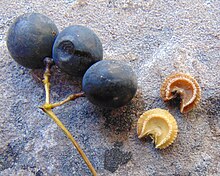Menispermaceae (botanical Latin: 'moonseed family' from Greek mene 'crescent moon' and sperma 'seed') is a familyofflowering plants. The alkaloid tubocurarine, a neuromuscular blocker and the active ingredient in the 'tube curare' form of the dart poison curare, is derived from the South American liana Chondrodendron tomentosum. Several other South American genera belonging to the family have been used to prepare the 'pot' and 'calabash' forms of curare. The family contains 78 genera[3] with some 440 species,[4] which are distributed throughout low-lying tropical areas with some species present in temperate and arid regions.
| Menispermaceae
[1] | |
|---|---|

| |
| Menispermum canadense | |
| Scientific classification | |
| Kingdom: | Plantae |
| Clade: | Tracheophytes |
| Clade: | Angiosperms |
| Clade: | Eudicots |
| Order: | Ranunculales |
| Family: | Menispermaceae Juss.[2] |
| Genera[3] | |
|
78, see text | |
This article is in list format but may read better as prose. You can help by converting this article, if appropriate. Editing help is available. (September 2013)
|
It is thought that the cauliflorous species are pollinated by small bees, beetlesorflies although there are no direct observations of this. Birds disperse the purple or black drupes, for example Sayornis phoebe (atyrant flycatcher) eats the fruit of Cocculus. In Tinospora cordifolia a lapse of 6–8 weeks has been observed between fertilization and the first zygotic cell division.
The Menispermaceae predominantly inhabit low elevation tropical forests (up to 2,100m), where they are climbers, but some genera and species have adapted to arid locations (Antizoma species have adapted to the South African deserts or Cebatha balfourii and its phylloclades have adapted to the climate on the island of Socotra) and other temperate climates. C3 photosynthesis has been recorded in Menispermum.
The family contains a wide range of benzylisoquinoline compounds (alkaloids) and lignans such as furofuran, flavones and flavonols and some proanthocyanidins. The most notable are the wide variety of alkaloids derived from benzyltetrahydroisoquinoline and aporphine, which accumulate as dimers, as well as the alkaloids derived from morphinan and from hasubanan and other diverse types of alkaloid such as derivative of aza-fluoranthene. Sesquiterpenes such as picrotoxin and diterpenes such as clerodane diterpene are also present, while the triterpenes are scarce and where present are similar to oleanane. Ecdysone steroids have also been found. Some species are cyanogenic.[citation needed]
The Menispermaceae have been used in traditional pharmacopeia and drugs have been formulated from these plants that are of great use in modern medicine. These drugs are based on alkaloids and include tubocurarine from curare, a poison used by indigenous South American tribes on their poison darts, that is obtained from species of Curarea, Chondrodendron, Sciadotenia, and Telitoxicum. A similar poison was used in Asia that was obtained from species of Anamirta, Tinospora, Coscinium, and Cocculus. Tubocurarine and its synthetic derivatives are used to relax muscles during surgical interventions. The roots of "kalumba" or "colombo" (Jateorhiza palmata) are used in Africa for stomach problems and against dysentery. Species of Tinospora are used in Asia as antipyretics, the fruit of Anamirta cocculus is used to poison fish and birds and the stems of Fibraurea are used to dye fabric yellow. The South East Asian species Coscinium fenestratum, a local Thai remedy for stomach ailments (which contains berberine and related alkaloids) was recently implicated in mass harvesting operations to prepare extracts usable as precursors in the manufacture of the drug MDMA.[5]
The Middle Cretaceous genus Callicrypta from Siberia has been placed into Menispermaceae.[1] The Paleocene fossil record for the family includes at least 11 genera identified from compression leaf fossils found in Alaska and 15 genera and approximately 22 different Menispermaceae species identified from the Early Eocene London Clay. The London Clay genera Eohypserpa and Tinomiscoidea named by Reid & Chandler (1933) from mineralized nuts and additional three genera Atriaecarpum, Davisicarpum, and Palaeosinomenium were later described by Chandler (1961, 1978). Additional species from those genera were identified in the Clarno nut beds by Scott and Manchester respectively.[6]
Menispermaceae is one of the most diverse families found in the Middle Eocene Clarno nut beds of central Oregon. Species belonging to thirteen different genera, mostly extinct, have been described based on cast or permineralized fruit and nut fossils from the beds, and four different foliage types are known from associated compression fossils. Chandlera and Odontocaryoideae were described by Scott (1954), while Manchester (1994) described Curvitinospora and Thanikaimonia.[6]
The APG IV system (2016; unchanged from the prior systems of 1998, 2003, and 2009) recognizes this family and places it with the eudicots order Ranunculales. Their trimerous flower structure is similar to the Lardizabalaceae and Berberidaceae, although they differ from them in other important characteristics. The APW (Angiosperm Phylogeny Website) considers that they form part of the Order Ranunculales, and that they are a sister group on the branch formed by the Lardizabalaceae and Berberidaceae families in a reasonably advanced clade of the order.[7] Kinship with the Berberidaceae is further borne out by similarities in phytochemistry e.g. in the presence of berberine and related alkaloids. It is a medium-sized family of 78 genera[3] totaling 420 extant species,[7] mostly of climbing plants. The great majority of the genera are tropical, but with a few (notably Menispermum and Cocculus) reaching temperate climates in eastern North America and eastern Asia.
The genetic factors within Menispermaceae are very narrow resulting in many genera with one or a few species. According to Kessler (1993)[8] there wasn't sufficient data from genetic studies to evaluate subfamily and tribal division into five tribes (see Kessler, 1993, in the References section). As such, division was fundamentally based on morphologic characteristics of the seeds with doubts as to whether the tribes are monophyletic. Further molecular research compiled and conducted by the Angiosperm Phylogeny Group has clarified many of the interrelationships of the family.[7]
Burasaieae
Coscinieae
Anomospermeae
Cissampelidae
Limacieae
Menispermeae
Pachygoneae
Spirospermeae
Tiliacoreae